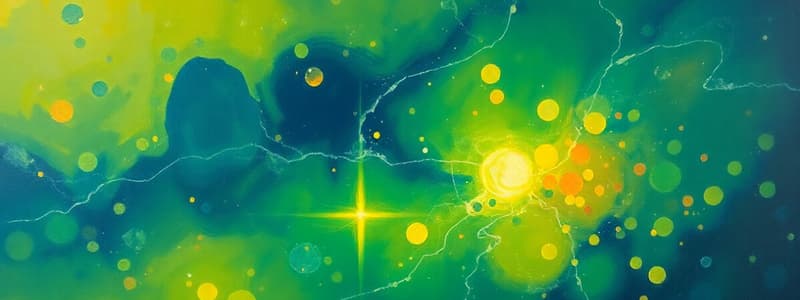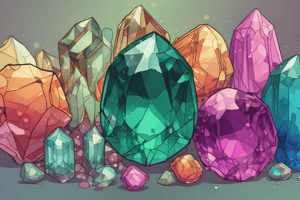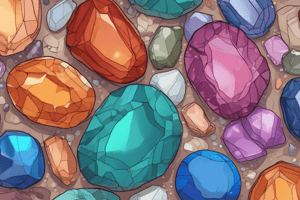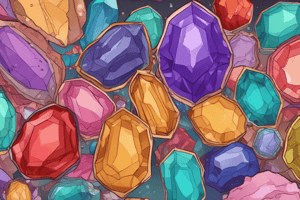Podcast
Questions and Answers
In gemstones, colour can arise from various causes, including metal-to-metal ______ transfer, where electrons move between metal ions.
In gemstones, colour can arise from various causes, including metal-to-metal ______ transfer, where electrons move between metal ions.
charge
A vacancy colour centre occurs when an ______ is missing from the crystal lattice, resulting in the absorption of light and the perception of colour.
A vacancy colour centre occurs when an ______ is missing from the crystal lattice, resulting in the absorption of light and the perception of colour.
atom
In electron colour centres, an electron becomes trapped in a ______ within a crystal structure, affecting how light is absorbed and reflected.
In electron colour centres, an electron becomes trapped in a ______ within a crystal structure, affecting how light is absorbed and reflected.
vacancy
Vibronic colour centres in diamond involve nitrogen as a trace element, where surrounding atoms create absorption leading to the appearance of ______ and yellow hues.
Vibronic colour centres in diamond involve nitrogen as a trace element, where surrounding atoms create absorption leading to the appearance of ______ and yellow hues.
Plastic deformation, or distortion in a stone's internal structure, is caused by stress, leading to colour change through a mechanism that remains ______.
Plastic deformation, or distortion in a stone's internal structure, is caused by stress, leading to colour change through a mechanism that remains ______.
The electron energy band gap, crucial in band gap theory, is the energy gap between 'valence band' electrons and 'conduction band' electrons, determining the gem's ______ properties.
The electron energy band gap, crucial in band gap theory, is the energy gap between 'valence band' electrons and 'conduction band' electrons, determining the gem's ______ properties.
When the band gap is larger than the energy range of visible light, the material appears ______ because the light doesn't interact with the electrons.
When the band gap is larger than the energy range of visible light, the material appears ______ because the light doesn't interact with the electrons.
In band gap theory, if the band gap is lower than that of the visible spectrum, the material absorbs all visible light and most light is immediately ______.
In band gap theory, if the band gap is lower than that of the visible spectrum, the material absorbs all visible light and most light is immediately ______.
Nitrogen atoms modify the colour of diamonds by creating a 'donor' level, allowing electrons to interact with light, so that it absorbs ______ photons.
Nitrogen atoms modify the colour of diamonds by creating a 'donor' level, allowing electrons to interact with light, so that it absorbs ______ photons.
Diamonds containing boron as a major impurity can conduct ______, and the higher the boron concentration, the greater the conductivity and the more intense the blue colour.
Diamonds containing boron as a major impurity can conduct ______, and the higher the boron concentration, the greater the conductivity and the more intense the blue colour.
In Type Ia diamonds, nitrogen atoms dispersed throughout the structure aggregate over time due to heat and pressure, typically forming groups of three or ______ atoms.
In Type Ia diamonds, nitrogen atoms dispersed throughout the structure aggregate over time due to heat and pressure, typically forming groups of three or ______ atoms.
Type IIa diamonds are almost pure, containing negligible amounts of nitrogen, and appear colourless as long as no pervading ______ are present.
Type IIa diamonds are almost pure, containing negligible amounts of nitrogen, and appear colourless as long as no pervading ______ are present.
Diamonds with vacancies caused by irradiation exhibit absorption at 741nm, also known as the ______ band, a characteristic feature used in identification.
Diamonds with vacancies caused by irradiation exhibit absorption at 741nm, also known as the ______ band, a characteristic feature used in identification.
HPHT treatment is used to make brown diamonds more colourless or produces stones with a fancy ______ hue due to nitrogen content.
HPHT treatment is used to make brown diamonds more colourless or produces stones with a fancy ______ hue due to nitrogen content.
Diamonds are primarily found in volcanic rocks such as kimberlite and lamproite, or in alluvial deposits after ______ from these rocks.
Diamonds are primarily found in volcanic rocks such as kimberlite and lamproite, or in alluvial deposits after ______ from these rocks.
The lustre of pearl, known as 'orient', is a combination of surface reflection and subtle ______, contributing to its unique appearance.
The lustre of pearl, known as 'orient', is a combination of surface reflection and subtle ______, contributing to its unique appearance.
Mabe pearls are a modern type of cultured blister pearl, produced by inserting a dome-shaped object between the ______ and the oyster's shell.
Mabe pearls are a modern type of cultured blister pearl, produced by inserting a dome-shaped object between the ______ and the oyster's shell.
The value of a pearl is influenced by nacre thickness along with colour, lustre, shape and surface smoothness and size which can be assessed down a ______ hole.
The value of a pearl is influenced by nacre thickness along with colour, lustre, shape and surface smoothness and size which can be assessed down a ______ hole.
Banded saltwater cultured pearls are created by rearing oysters in pearl farms, where oysters implanted with one or more mother-of-pearl ______.
Banded saltwater cultured pearls are created by rearing oysters in pearl farms, where oysters implanted with one or more mother-of-pearl ______.
In freshwater pearls formation requires mature mussels which are dredged from lakes and then small pieces of mantle tissue are inserted from a ______ mussel.
In freshwater pearls formation requires mature mussels which are dredged from lakes and then small pieces of mantle tissue are inserted from a ______ mussel.
In gemstones such as sapphire, which elements primarily contribute to its blue and yellow colouration through metal-to-metal charge transfer?
In gemstones such as sapphire, which elements primarily contribute to its blue and yellow colouration through metal-to-metal charge transfer?
Which gemstone's colour can arise from the presence of organic matter within its structure?
Which gemstone's colour can arise from the presence of organic matter within its structure?
For a quartz crystal that has been irradiated over a long period and subsequently heated, what change would be expected in its colour?
For a quartz crystal that has been irradiated over a long period and subsequently heated, what change would be expected in its colour?
What causes purple colouration in fluorite?
What causes purple colouration in fluorite?
Type 1AAB yellow diamonds exhibit a spectral line at 415nm. What contributes to its presence?
Type 1AAB yellow diamonds exhibit a spectral line at 415nm. What contributes to its presence?
Materials with a band gap lower than the visible spectrum typically show what optical property?
Materials with a band gap lower than the visible spectrum typically show what optical property?
In diamonds, how does the presence of nitrogen atoms influence colour?
In diamonds, how does the presence of nitrogen atoms influence colour?
What is the role of boron in Type IIb diamonds regarding electrical conductivity and colour?
What is the role of boron in Type IIb diamonds regarding electrical conductivity and colour?
Type Ia diamonds containing aggregates of nitrogen atoms typically exhibit what optical characteristic?
Type Ia diamonds containing aggregates of nitrogen atoms typically exhibit what optical characteristic?
Why are synthetic diamonds with dispersed nitrogen atoms considered 'new'?
Why are synthetic diamonds with dispersed nitrogen atoms considered 'new'?
What causes type IIb diamonds to absorb energy in the longer visible wavelengths thus causing a blue hue?
What causes type IIb diamonds to absorb energy in the longer visible wavelengths thus causing a blue hue?
HPHT treatment to diamonds with high nitrogen content can result in what colour change?
HPHT treatment to diamonds with high nitrogen content can result in what colour change?
What is added to assist in melting to cause the formation of synthetic diamonds?
What is added to assist in melting to cause the formation of synthetic diamonds?
What element is typically present in CVD synthetic diamonds?
What element is typically present in CVD synthetic diamonds?
Why is the cut of 47 facets (58 with culet) round brilliant designed as?
Why is the cut of 47 facets (58 with culet) round brilliant designed as?
Why is synthetic moissanite easily identified?
Why is synthetic moissanite easily identified?
What process most accurately describes Beryllium diffusion?
What process most accurately describes Beryllium diffusion?
What heating process transforms transparent zoisite into tanzanite?
What heating process transforms transparent zoisite into tanzanite?
After HPHT treatment, Type IIa brown diamond will display what colour?
After HPHT treatment, Type IIa brown diamond will display what colour?
How can the effectiveness of foil treatment be easily assesed?
How can the effectiveness of foil treatment be easily assesed?
Flashcards
Sapphire Colour Source
Sapphire Colour Source
Sapphire's blue color results from Iron and Titanium interactions.
Vacancy Colour Centre
Vacancy Colour Centre
Caused by missing atoms in the crystal lattice, creating electron energy level shifts.
Band Gap Theory
Band Gap Theory
The gap in energy between valence and conduction band electrons, determining light absorption.
Type I Diamond
Type I Diamond
Signup and view all the flashcards
Green Diamonds
Green Diamonds
Signup and view all the flashcards
Black Diamonds
Black Diamonds
Signup and view all the flashcards
Pink & Red Diamond Color
Pink & Red Diamond Color
Signup and view all the flashcards
Synthetic Diamond
Synthetic Diamond
Signup and view all the flashcards
Pearl Colour
Pearl Colour
Signup and view all the flashcards
Natural Pearl Structure
Natural Pearl Structure
Signup and view all the flashcards
Types of Inclusions
Types of Inclusions
Signup and view all the flashcards
EDXRF
EDXRF
Signup and view all the flashcards
Prism Spectroscope
Prism Spectroscope
Signup and view all the flashcards
Chelsea Colour Filter
Chelsea Colour Filter
Signup and view all the flashcards
Heating
Heating
Signup and view all the flashcards
Impregnation
Impregnation
Signup and view all the flashcards
Oiling
Oiling
Signup and view all the flashcards
Fracture Filling
Fracture Filling
Signup and view all the flashcards
Hole Colour Centre
Hole Colour Centre
Signup and view all the flashcards
Electron Colour Centre
Electron Colour Centre
Signup and view all the flashcards
Vibronic Colour Centres
Vibronic Colour Centres
Signup and view all the flashcards
Plastic Deformation
Plastic Deformation
Signup and view all the flashcards
Band Gap Larger Than VIS
Band Gap Larger Than VIS
Signup and view all the flashcards
Band Gap Lower Than VIS
Band Gap Lower Than VIS
Signup and view all the flashcards
Band Gap Overlapping VIS
Band Gap Overlapping VIS
Signup and view all the flashcards
Yellow Diamond Colour
Yellow Diamond Colour
Signup and view all the flashcards
Blue Diamond Colour
Blue Diamond Colour
Signup and view all the flashcards
Type IIb Diamonds
Type IIb Diamonds
Signup and view all the flashcards
Type I Testing
Type I Testing
Signup and view all the flashcards
Pearl Nacre layers
Pearl Nacre layers
Signup and view all the flashcards
Marine Pearl Process
Marine Pearl Process
Signup and view all the flashcards
Diamond Fluorescence
Diamond Fluorescence
Signup and view all the flashcards
Mabe Pearl creation
Mabe Pearl creation
Signup and view all the flashcards
Study Notes
### Causes of Color in Gemstones
- Color in gemstones can arise from various mechanisms related to their chemical composition and crystal structure.
### Metal-to-Metal Charge Transfer
- This involves the transfer of electrons between metal ions within the gemstone's structure, causing selective light absorption.
### Oxygen-to-Metal Charge Transfer
- A charge transfer mechanism where electrons move from oxygen to a metal ion, leading to color.
### Charge Transfer Without Metal Ions
- Color can also result from charge transfer processes that don't involve metal ions directly.
### Vacancy Color Center
- Occurs when an atom is missing from the crystal lattice, the resulting electron utilizes photons of light to jump to a higher energy level.
- The observed absorption is in the red part of the spectrum, leading to a green color perception.
### Hole Color Center
- Created when irradiation displaces an electron from its orbit, enabling other atoms to absorb light thus creating colour.
### Electron Color Centers
- An electron becomes trapped in a vacancy within the crystal structure, resulting in color.
### Vibronic Color Centers
- In diamonds, nitrogen trace elements surrounding a vacancy cause absorption due to both color center and molecular vibrations.
- This combined effect results in the perception of blue and yellow colors.
### Plastic Deformation
- Internal strain within the stone, often caused by stresses in the Earth’s mantle, can lead to color changes.
- The exact mechanism is not well understood.
### Band Gap Theory
- The electron energy band gap refers to the energy difference between valence band electrons and conduction band electrons.
- The width of the band gap is influenced by the gem's chemistry and crystal structure.
### Band Gap Larger than the VIS Energy Range
- When the band gap is larger than the energy range of visible light, no light is absorbed.
- The material appears transparent and colorless if pure.
### Band Gap Lower than the VIS Spectrum
- If the band gap is lower than the visible spectrum, all visible light is absorbed.
- The material appears opaque, with most light immediately re-emitted, creating a shiny appearance.
### Band Gap Overlapping VIS Spectrum
- Occurs when light is selectively absorbed within the visible light range due to overlapping band gaps.
- Chemical impurities can introduce additional electron energy levels.
- These impurities enable selective absorption, resulting in color.
### Examples of Gemstones with specific causes of colour
- Sapphire's blue color is due to Fe2+ and Ti4+ impurities.
- Amethyst's purple color is caused by Fe2+, with a yellow component from Fe3+.
- Yellow beryl contains O2- and Fe3+.
- Green diamonds can be naturally or artificially colored by radiation.
- The GR1 absorption line is at 741nm.
### Quartz
- Irradiation over long periods can eject electrons, causing absorption and black coloration.
- This coloration can be reversed with heating.
### Purple Fluorite
- In purple fluorite, a fluorine ion is missing, leading to an electron filling the vacancy.
- This electron absorbs yellow light, resulting in the perception of purple.
### Yellow Diamond (Type 1AAB)
- A spectral line may be observed at 415nm.
- Can exhibit blue fluorescence under long-wave UV light, creating an apparent blue body color if strong enough.
### Pink, Mauve, and Brown Diamonds
- Believed to be colored by plastic deformation and can be treated with HPHT.
### Yellow Diamonds
- When nitrogen replaces carbon in the diamond lattice, it introduces a 'donor' level.
- Electrons move to the conductance band, interact with light energy, and absorb violet photons.
- This results in a 'canary' yellow color in proportion to the concentration of nitrogen atoms.
### Blue Diamonds
- When carbon is replaced by boron with only three outer electrons, there is a deficiency of one electron and boron forms acceptor level.
- Energy is absorbed near infrared, while blue and violet energy levels are transmitted.
### Electrical Current in Diamonds
- Boron's position near the top of the valence band allows for thermal excitation of electrons.
- This creates 'holes' in the valence band, enabling electrical current flow.
- Diamonds containing boron as a major impurity conduct electricity.
- Higher boron concentration equates to greater electrical conductivity and blue color.
- Non-conducting blue diamonds can be created by color centers.
### Type Ia Diamonds
- The majority of natural diamonds are Type Ia, known as the Cape series.
- Believed to have formed with nitrogen dispersed as individual atoms, then aggregated over time due to heat and pressure.
- Most have aggregates of three nitrogen atoms around a vacancy.
- This creates a color center that absorbs energy in the blue region, resulting in a yellow tint.
- Plastic deformation can occur, leading to brown, pink, or red coloration with absorption at 503nm.
- Testing involves observing blue fluorescence under UV light, which can be masked by body color.
- Sharp absorption line at 415nm, may be accompanied by up to five other weak bands in the violet.
### Type Ib Diamonds
- A deep golden yellow may be observed, traditionally called 'Canary' yellow.
- Believed to have formed with nitrogen dispersed as single nitrogen atoms.
- Nitrogen occurs as isolated atoms replacing carbon atoms randomly.
- The surplus electron in bonding leads to the absorption of blue light, resulting in a yellow color.
- Natural type 1b diamonds are rare.
- Many synthetic diamonds are type Ib because their dispersed nitrogen atoms haven't had time to aggregate.
- Testing involves absorption in the blue region, sometimes with peaks at 503nm and 637nm.
### Type IIa
- Almost pure, containing negligible amounts of nitrogen.
- Appear colorless if no pervading impurities or imperfections are present.
### Type IIb
- Contain boron atoms as a major impurity.
- Boron atoms have deficiency in energy, is absorbed in the longer visible wavelengths
- This results in a blue color.
- The Hope diamond is a famous example.
- Exhibits unusual electrical properties due to boron.
- Inert under LWUV, with red fluorescence in SWUV.
### Green Diamonds
- Vacancies caused by irradiation lead to absorption at 741nm (GR1).
- Brown, greenish-yellow, and green stones show green fluorescence, and may show a narrow band at 503nm + weaker bands in the blue and green.
### Black Diamonds
- A large number of dark, opaque inclusions cause black color.
### Pink and Red Diamonds
- May be caused by plastic deformation and found at 560nm.
### Brown Diamonds
- Caused by plastic deformation and found at 560nm.
### Diamond Synthesis
- Laboratory techniques duplicate the conditions of natural diamond formation.
- Two main processes are used: HPHT and CVD.
### Diamond Synthesis: HPHT
- Creates synthetic diamonds under high temperature and pressure.
- Replicates the conditions of mantle-grown diamonds.
- BARS and Belt processes differ in how pressure is applied to the reaction cell.
- Reaction cell is kept at high temperatures (1350-1600°C) and pressures (50-80 kbars).
- Carbon feed material (graphite or diamond powder) is used.
- A catalyst (flux) like nickel, iron, or cobalt assists in melting the carbon.
- Temperature at the base of the reaction cell is slightly lower.
- Encourages crystal growth on a seed crystal.
### Diamond Synthesis: CVD
- No sublimation process is needed as ingredients come in gaseous form.
- A combination of methane, hydrogen, oxygen, and argon is passed through a microwave.
- Atoms of carbon are deposited on seed plates to build a diamond crystal.
- Developments using a seed crystal of diamond are suitable for manufacturing.
- Increasingly abundant due to quicker growth rates and lower cost.
### Distinguishing Features of Synthetic Diamonds
- Synthetic diamonds often contain metallic flux and dust inclusions.
- Hourglass color zoning.
- Metal catalyst may be discovered as inclusions.
- Distinctive crystal habit, forming combined shapes like truncated cubes or octahedrons.
- UV fluorescence is stronger in short wave than long wave.
- Typically shows yellow or yellow-green fluorescence.
- Phosphorescence may occur after shortwave UV.
- Note, only approximately 1/3 fluoresce.
- Most natural diamonds have an absorption band at 415nm; this is not found in synthetic diamonds.
- Exhibits magnetism - some attracted to high powered magnet.
- Detects the 415nm absorption seen in most diamonds.
### Diamond Mining
- Diamonds found in kimberlite and lamproite, or in river/beach gravels after erosion.
- 100 tonnes of ore contain only 1g (5ct) of gem-quality diamonds.
- Diamonds may be laser drilled to reduce visual impact of dark inclusions.
- Exceptional hardness, brilliance, fire, luster sets them apart
- Thermal tests separate diamonds from simulants.
- Fluorescence: ranges from inert to strong.
- Natural diamonds most fluoresce to LWUV light, bluish-white in hue.
- Visual clarity assessed from Flawless (FL) to Imperfect (I)
- Clarity: number, size, position, nature, brightness of inclusions
- Cut: style, symmetry, proportions and polish is tested
### Pear Lustre
- Pearl lustre is unique and complicated, also known as orient
- It is caused by the reflection of light and iridescence of light.
- Pearl nacre consists of organic-rich layer and aragonite
- May be damaged by parasites, disease or predator attack from pests.
- Created using tissue nucleation process using a section of the mantle.
### Imitation Pearls
- With coated surfaces has layers or chipping of the coating around drill holes.
- Its surface may appear granular when compared with overlapping pearl structure.
- Pearl quality is assessed in reference to its luminescence, color, shape, surface and size.
### Marine Pearl Creation
- The process involves pearl farms and the creation of oysters by pearl farmers.
- The growing process is from for 2-3 years with constant care until a nacre forms.
- Akoya pearls produce mostly smaller, white pearls
- Oysters grow to 10cm big.
- Black-lipped South Sea pearl oysters produce black and grey iridescent pearls
- Silver and Gold lipped South Sea pearl oysters produce larger white and golden pearls.
- Mabe oyster produce Mabe pearls
### Freshwater Pearls Creation
- The pearl mussels are harvested and small pieces of the mussel are placed, then suspended in lakes.
- For smaller pearls, up to 30 can be grown at the same time.
- Larger pearls product less.
- Freshwater pearls turn grey with irradiation.
### Quality Factors In Gemstones
- The most valuable rubies have a good rich red color which are often free from inclusions.
- Best quality emeralds have rich soft green which is often higher in value.
- Zambian emeralds are said to have a cooler bluish-green colour.
### Types Of Inclusions
- Existed as a complete material prior to being enveloped referred to as Protogenetic
- Formed at the same time as the host gem and was therefore Brough into existence by the formation gemstone referred to Syngenetic
### Laboratory Testing: Energy Dispersive X-Ray Fluorescence Spectroscopy (EDXRF)
- Detects trace element impurities
- Distinguishes between natural and synthetic materials
- Helps identify locality and origin.
### Laboratory Testing: Scanning Electron Microscope (SEM)
- Used to learn about the surface of the gemstone in extraordinary detail prior to treatment.
- Uses a beam of electrons is projected onto material's surface
### Laboratory Testing: Fourier Transform Infrared Spectroscopy
- Useful to detect treatments.
- Can identify diamond types and separate natural and synthetic gem materials.
### Laboratory Testing: Laser Raman Spectroscopy (LRS)
- Identifies gemstone and inclusion
- Can detect a wide range of treatments
- Insight on origin and locality, and can identify evidence of HPHT treatment of diamond
### Laboratory Testing: Ultraviolet-Visible-Near-Infrared Spectroscope (UV-Vis-NIR)
- determines the origin.
- identifies HPHT treatment in diamonds
- Identify synthesis in emerald (based on absorption) and corundum (based on presence of iron)
### Gemological Testing: Spectroscope
- Composed of prisms (formed of two types of glass) which produce a spectrum by refraction and dispersion
- Fine ruled grating which produces a spectrum by diffraction, light from the split is focused onto the grating
### Gemological Testing: Refractometer
- RI of material is related to its critical angle
- Distant Vision technique is commonly used.
- Stone on table with fluid, look through eyepiece
- Bright Line Technique creates rainbows
### Gemological Testing: Polariscope
- Two filters: 'Polariser' and 'the Analyser'
- Isotropic materials remain dark while Anisotropic show different light directions
- Used the detect UV light
### Gemological Testing: Dichroscope
- Calicte or London
- Can distinguish between UV light
- Alexandrite shows red, orange and green
- Iolite shows violet blue , pale blue and pale yellow to colourless
- Tanzanite shows violet blue , pale blue and yellow green
#### Treatment
- Can change or improve its appearance
- Some Treatments are bleaching to improve color
### Treatment: Bleaching
- Effective in porous gems.
- Identification difficult unless colour changes drastically
### Treatment: Dyeing
- Introduced to permeable materials to alter or produce colour
- Can easily be removed
- Observable in cracks and fissures.
### Treatment: Coating
- Applied to change color
- Non permanent
- May be observable with evidence of wear or spectrum is easily removable.
- Foiling to give gem brilliance and is best used on loose stones.
### Treatment: Impregnation
- Apply wax or polymer resin to the surface of porous stone to toughness and is best on turquoise and jadeite.
### Treatment: Healing/Heating
- Most pink topaz on the market is heat treated to create pink/purple-red topaz and is most commonly done with clear amber
### Treatment:Fracture filling
- Used to filling on fractures to avoid cracks from appearing
Studying That Suits You
Use AI to generate personalized quizzes and flashcards to suit your learning preferences.




